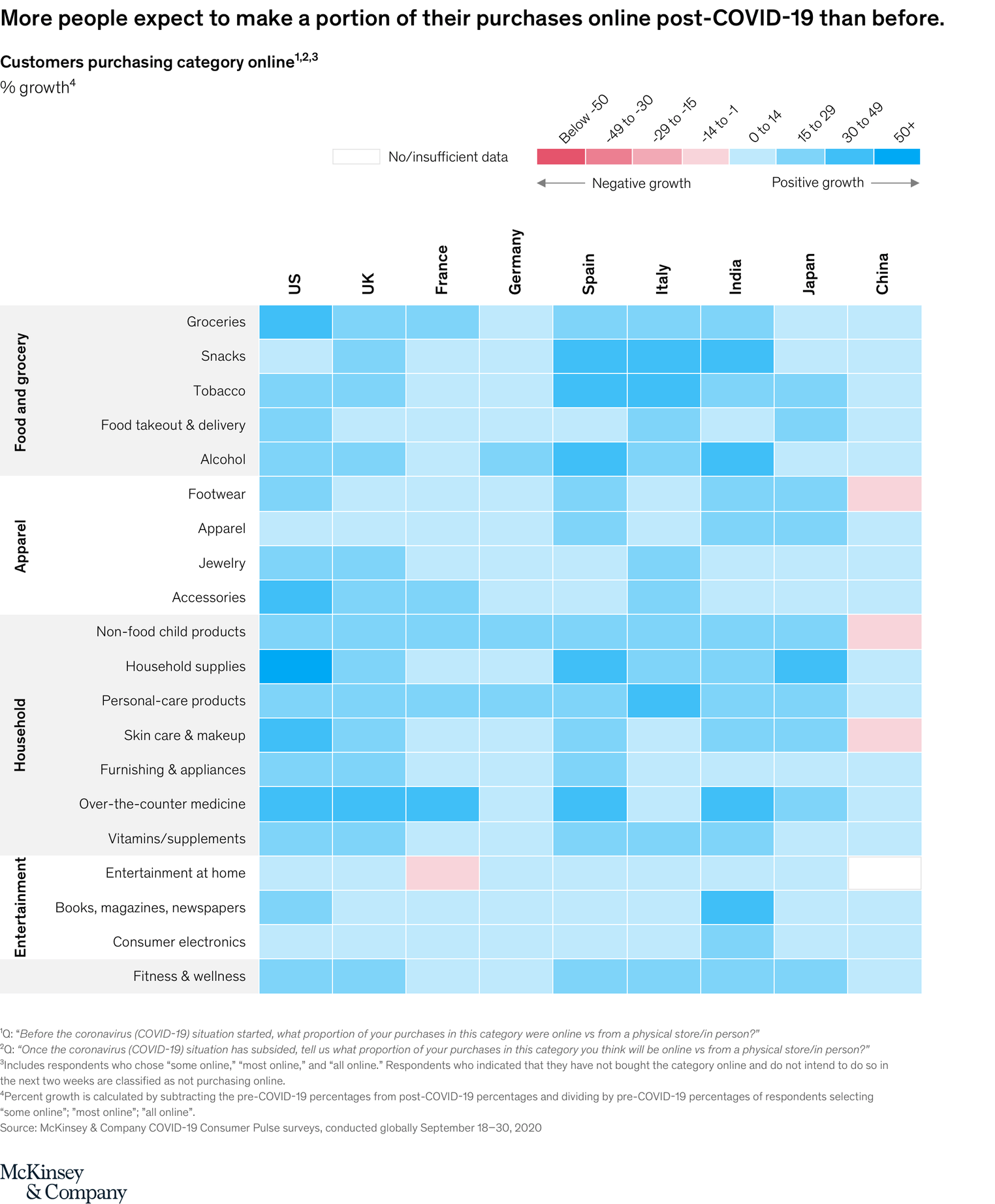
How to Find the Most Effective Digital Marketing Channel for You
It’s an age-old question: In a world with limited budgets and even more limited time to execute them, what’s the most effective digital marketing channel?
Digital marketing is quickly becoming the default strategy for most teams, with marketers primarily spending on the customer experience (9% of budgets) over branding (7.1%) and innovation (6.1%), according to The CMO Survey’s February 2020 report.
That’s because of a shift in consumer behavior that’s been accelerated even more by the COVID-19 pandemic. Customers expect to purchase everything online, whether that’s B2B customers looking to research your services through chat and web channels or consumers ready to purchase traditional brick-and-mortar items like household goods, groceries, and even fitness services.
With so many companies pivoting to digital marketing, how will you stand out?
The answer is simpler than you think: by using the right channel at the right time.
More people are online now than ever before, and 62.3% of marketers say that marketing has become more important since COVID-19. Since people expect to be able to do more through technology, you’ll need to find the best ways to reach them. Done right, a digital channel strategy can help you cut through the noise from not only your direct competitors but also the general distractions of the Internet.
Which Digital Marketing Channel Should I Use?
Determining where to allocate your budget depends on several factors. Consider:
- Your goals. The functions of marketing channels align with different business outcomes. What do you want to achieve first and foremost: more traffic, more clicks, or more sales? (Of course, you probably want to achieve all three. But you’ll need to prioritize which of these is most important to move the needle for your business and/or satisfy your boss.)
- Your customers. You have to know your audience. Every channel slots into a different stage of the customer journey, so you’ll need to map out how they think about purchasing from you and your competitors and tailor your strategy to match.
- Your budget. Established channels are a go-to option because they work… But of course, you’ll need to pay more to see results than with more organic growth. The good news? You get what you pay for—especially with paid social and PPC, which can deliver a great ROI.
How to Choose the Most Effective Digital Marketing Channels for Your Business
So, how can you choose which type of marketing is best? Choosing the most effective digital marketing channels for your business comes down to the resources you have. With so many to choose from, you’ll need to prioritize your options based on your most immediate needs and expand from there.
If you’re low on traffic…
That’s your first priority. It’s like that famous philosophical question: If a tree falls in a forest and no one is around to hear it, does it still make a sound?
It’s the same with your products and services. You can have the best products in the world, but if no one knows about them, you’ll never make a sale.
The more traffic you have, the more sales you’ll make. And the best way to quickly drive more traffic to your website is through paid media channels, including PPC or display advertising channels like paid social. This also gives you a leg up when you do choose to invest in SEO since it’s easier to rank for search terms if you have more traffic.
Invest in PPC
Paid search (Google and Bing) has the potential to give you an ROI quickly because people actively turn to search engines to discover solutions to their specific problems. You have the ability to capture people right away as they look for solutions and information to their problems.
While paid search can be an extremely powerful channel, it does require a decent budget to work effectively. You’ll need to evaluate which keywords should receive your allocated spend and, if necessary, allocate your budget to outsource this skill (give WebMechanix a ring if you need help).
To get the most out of your paid media campaigns:
- Perform a paid search audit to see what’s already working and what’s not.
- Choose relevant keywords that match search intent for your audience and add negative keywords.
- Narrow in on the right section of your audience to target and create lookalike audiences.
- Match your ads with the same marketing message on landing pages.
- Test different marketing messages to see what works best with each campaign.
- Give retargeting a shot. It’s a great place to start when it comes to paid media since it’s often the most affordable option and gives you the highest ROI.
More is more with PPC, but only up to a point. Once you generate enough traffic, you can reallocate your budget to other channels to eliminate the diminishing returns from exhausting a given platform.
Choosing the Right Paid Social Channels
More marketers are spending money on paid channels than ever before, according to The CMO Survey. Social media budgets increased 74% since February 2020, rising from 13.3% of marketing budgets to 23.2%, with marketers mainly using social media for brand-building (84.2%) and customer retention (54.3%).
But which social media platform you choose depends on your audience. You want to be where they are, not where you think they are. Depending on your business model, you have a few marketing channel examples to choose from:
- LinkedIn: 79% of B2B marketers say that LinkedIn is a proven workhorse for generating leads. And recent research from HubSpot also shows that LinkedIn can be 277% more effective for B2B lead generation than Facebook and Twitter. If you’re reaching a business audience, LinkedIn is a great place to start.
- Facebook: 61% of marketers claim that Facebook is their most important social platform. With 2.7 billion monthly active users, you’re going to be able to directly target anyone. At WebMechanix, we’ve often found that Facebook can deliver a cheaper cost per lead without sacrificing on lead quality. The sheer volume of traffic Facebook allows you to find who you’re looking for, even sometimes for B2B.
- Instagram and SnapChat: For B2C companies targeting younger audiences, consider media that place a greater focus on media. According to Hootsuite, 67% of 18–29-year-olds use Instagram, and 85% of teens say that it’s their preferred social network, followed by Snapchat.
- Quora, Twitter, and Reddit: While these platforms may not deliver the same amount of leads, they’re great for brand awareness campaigns. The key for advertising is repetition, so you’ll need to show up everywhere.
- New platforms, like TikTok: Always keep an eye out for newer platforms, especially if you’re targeting younger audiences. Brands like the NBA, BMW, and MAC Cosmetics all hopped aboard the TikTok train early on, giving them a significant advantage as early adopters of this new platform.
If you’re low on conversion…
Traffic is only part of the story. To get the sale, you need to usher a prospect all the way through the funnel to conversion. When they arrive on your website, do they stay?
Conversion rate optimization (CRO) improves your website’s conversion funnel, building a continuous cycle of website tests designed to maximize performance. This can be anything from simple tests on CTA button colors to larger overhauls of your homepage, pricing page, or specific product landing pages.
Investing in CRO is ideal once you have plenty of traffic to work with, both for testing statistical significance and for understanding which parts of the funnel cause prospects to drop off or abandon their session.
A low conversion rate suggests that there may be a misalignment between your content and promotions and what your target audience expects once they arrive on your website. To understand that mismatch—and close the gaps—you’ll need to approach your website with a scientific eye, using tools like:
- Heatmaps to understand where visitors click.
- User session recordings to see how visitors move through your pages.
- A/B testing to isolate variables like colors, fonts, placement, and copy.
- Qualitative surveys to add a human perspective to your quantitative data.
That’s because CRO is ultimately a balance between conversion and user experience. Creating a seamless user experience that makes it easy for your customers to purchase from you isn’t an overnight process but rather a long-term effort that involves team members across your engineering, product, marketing, and design teams.
If you’re low on budget…
There’s still good news. Organic marketing channels aren’t going anywhere—they just take more time.
Investing in SEO by creating quality long-form content builds more trust and can help your brand, especially if you don’t have the budget to spend on paid advertising. But SEO is a long game. It can take months to rank for a given keyword and even longer to rise high enough in the rankings to see significant traffic.
An effective SEO strategy requires several elements:
- Technical optimization of your website, including your site mapping, managing any duplicate content, redirects, reducing site load speed, or enabling certain code that makes it easier for search engines to crawl your site.
- A thorough content strategy that speaks to the value you deliver, crafting interesting, relevant and informative pieces of content—blog posts, landing pages, videos, and so on. Stick to specific themes that build up expertise around a topic that matches your offering. For example, retailer Patagonia often produces content around environmental or sustainable practices as they relate to its clothing manufacturing process. Of course, make sure you research and choose keywords with a low enough competition and traffic to rank on search engines.
- Obtaining backlinks, either internally through creating a web of interlinked content or through partner marketing efforts like guest posts, HARO, or PR efforts.
Consider your content the beginning of a relationship with a prospect, one that slowly turns them from interested to excited. The best content marketing strategies utilize content at all parts of the funnel, building a community.
Craft a solid digital channel strategy
Every organization’s path to digital marketing success is different. Here’s what we recommend when it comes to choosing the most effective digital marketing channels:
- Balance your goals, customer needs, and budget when choosing a channel.
- If you have low traffic and budget, fix those first with PPC and paid social campaigns.
- Once you have enough traffic, optimize for conversions with CRO.
- If you don’t have the budget to fully commit to either of those channels, investing in a quality content strategy and SEO will work—it just takes more time.
Not sure where to start? We’ve put together a quiz that can help you identify which channels are right for you. Answer five questions about your company and your current digital marketing to unlock your personalized marketing strategy in under two minutes. Get instant results and use these actionable tips to improve your campaigns!
Try it out now: https://www.webmechanix.com/strategy-generator/.
Most newsletters suck...
So while we technically have to call this a daily newsletter so people know what it is, it's anything but.
You won't find any 'industry standards' or 'guru best practices' here - only the real stuff that actually moves the needle.







